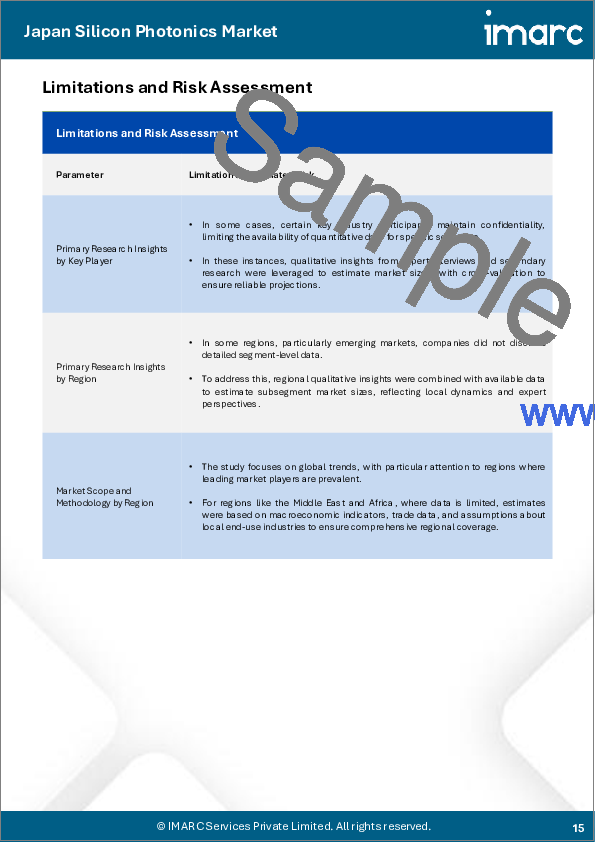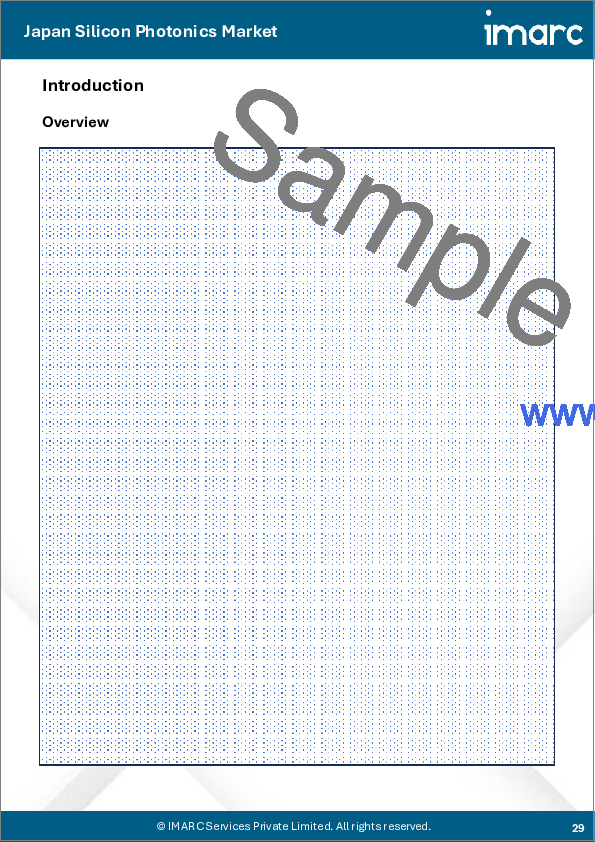|
|
市場調査レポート
商品コード
1609700
日本のシリコンフォトニクス市場レポート:製品、コンポーネント、用途、地域別、2025年~2033年Japan Silicon Photonics Market Report by Product, Component (Optical Waveguides, Optical Modulators, Photodetectors, Wavelength-Division Multiplexing Filters, Laser), Application, and Region 2025-2033 |
||||||
カスタマイズ可能
|
|||||||
| 日本のシリコンフォトニクス市場レポート:製品、コンポーネント、用途、地域別、2025年~2033年 |
|
出版日: 2024年12月05日
発行: IMARC
ページ情報: 英文 115 Pages
納期: 5~7営業日
|
全表示
- 概要
- 目次
日本のシリコンフォトニクス市場の市場規模は2024年に1億390万米ドルに達しました。今後、IMARC Groupは、市場は2033年までに8億1,960万米ドルに達し、2025年から2033年にかけて25.8%の成長率(CAGR)を示すと予測しています。5Gネットワーク、AI、IoTなど様々なアプリケーションにおける高速データ伝送のニーズに対する需要の高まりと、シリコンフォトニクスなどの光通信技術の新たな普及が市場を牽引しています。
本レポートで扱う主な質問
- 日本のシリコンフォトニクス市場はこれまでどのように推移し、今後どのように推移するのか?
- COVID-19が日本のシリコンフォトニクス市場に与えた影響は?
- 日本のシリコンフォトニクス市場の製品別の内訳は?
- 日本のシリコンフォトニクス市場のコンポーネント別の内訳は?
- 日本のシリコンフォトニクス市場の用途別の内訳は?
- 日本のシリコンフォトニクス市場のバリューチェーンにはどのような段階がありますか?
- 日本のシリコンフォトニクスの主な促進要因と課題は?
- 日本のシリコンフォトニクス市場の構造と主要プレーヤーは?
- 日本のシリコンフォトニクス市場における競合の程度は?
目次
第1章 序文
第2章 調査範囲と調査手法
- 調査の目的
- ステークホルダー
- データソース
- 市場推定
- 調査手法
第3章 エグゼクティブサマリー
第4章 日本のシリコンフォトニクス市場:イントロダクション
- 概要
- 市場力学
- 業界動向
- 競合情報
第5章 日本のシリコンフォトニクス市場情勢
- 過去および現在の市場動向(2019年~2024年)
- 市場予測(2025-2033)
第6章 日本のシリコンフォトニクス市場:製品別の内訳
- トランシーバー
- アクティブ光ケーブル
- 光マルチプレクサ
- 光減衰器
- その他
第7章 日本のシリコンフォトニクス市場:コンポーネント別の内訳
- 光導波路
- 光変調器
- 光検出器
- 波長分割多重(WDM)フィルター
- レーザ
第8章 日本のシリコンフォトニクス市場: 用途別の内訳
- ITおよび通信
- 家電
- ヘルスケアとライフサイエンス
- 商業
- 防衛と安全保障
- その他
第9章 日本のシリコンフォトニクス市場:競合情勢
- 概要
- 市場構造
- 市場プレーヤーのポジショニング
- 主要成功戦略
- 競合ダッシュボード
- 企業評価象限
第10章 主要企業のプロファイル
第11章 日本のシリコンフォトニクス市場:業界分析
- 促進要因・抑制要因・機会
- ポーターのファイブフォース分析
- バリューチェーン分析
第12章 付録
Japan silicon photonics market size reached USD 103.9 Million in 2024. Looking forward, IMARC Group expects the market to reach USD 819.6 Million by 2033, exhibiting a growth rate (CAGR) of 25.8% during 2025-2033. The increasing demand for need for high-speed data transmission in various applications such as 5G networks, AI, and IoT, coupled with the emerging popularity of optical communication technologies like silicon photonics, is driving the market.
Silicon photonics is an emerging technology that integrates optical components and circuits on silicon-based chips to transmit data using light instead of electricity. It harnesses the properties of silicon, the dominant material in the electronics industry, to enable high-speed data transfer and processing with minimal energy consumption. In silicon photonics, lasers or modulators create and manipulate light signals on silicon substrates, which can be easily integrated into existing semiconductor manufacturing processes. This technology is crucial for data centers, telecommunications, and high-performance computing, where the demand for faster and more energy-efficient data transfer is increasing. Silicon photonics offers advantages such as high bandwidth, low latency, and immunity to electromagnetic interference, making it ideal for transmitting vast amounts of data over long distances. It also facilitates the convergence of optical and electronic functions on a single chip, reducing cost and complexity. Overall, silicon photonics holds immense promise for revolutionizing communication and computing by enabling faster, more efficient, and cost-effective data transmission using light-based technologies.
Japan Silicon Photonics Market Trends:
The silicon photonics market in Japan is experiencing a remarkable surge, primarily driven by the incessant demand for high-speed data transmission and the growing need for energy-efficient solutions. Additionally, the proliferation of cloud computing and data centers has significantly bolstered the market, as silicon photonics provides an optimal solution for managing vast data loads with enhanced performance and reduced latency. Furthermore, the integration of silicon photonics in consumer electronics, particularly for applications like high-resolution displays and advanced sensing, is propelling market growth. Moreover, the telecommunication sector is leveraging silicon photonics for faster and more reliable network connections, thereby contributing to market expansion. Equally important, the automotive industry's adoption of silicon photonics for LiDAR and other sensing technologies is creating new growth avenues. Also, the escalating demand for high-performance computing is propelling market players to invest in silicon photonics, ensuring a competitive edge. Correspondingly, advancements in technology and innovation are making silicon photonics more accessible and cost-effective, thus driving market adoption. Consequently, with the integration of artificial intelligence and machine learning, silicon photonics is becoming indispensable for various industries, ensuring sustained market growth. All in all, the synergy of market drivers, such as technological advancements, growing demand from key industries, and the need for energy-efficient solutions, is ensuring a robust trajectory for the silicon photonics market in Japan.
Japan Silicon Photonics Market Segmentation:
Product Insights:
- Transceivers
- Active Optical Cables
- Optical Multiplexers
- Optical Attenuators
- Others
Component Insights:
- Optical Waveguides
- Optical Modulators
- Photodetectors
- Wavelength-Division Multiplexing (WDM) Filters
- Laser
Application Insights:
- IT and Telecommunications
- Consumer Electronics
- Healthcare and Life Sciences
- Commercial
- Defense and Security
- Others
Competitive Landscape:
The market research report has also provided a comprehensive analysis of the competitive landscape in the market. Competitive analysis such as market structure, key player positioning, top winning strategies, competitive dashboard, and company evaluation quadrant has been covered in the report. Also, detailed profiles of all major companies have been provided.
Key Questions Answered in This Report:
- How has the Japan silicon photonics market performed so far and how will it perform in the coming years?
- What has been the impact of COVID-19 on the Japan silicon photonics market?
- What is the breakup of the Japan silicon photonics market on the basis of product?
- What is the breakup of the Japan silicon photonics market on the basis of component?
- What is the breakup of the Japan silicon photonics market on the basis of application?
- What are the various stages in the value chain of the Japan silicon photonics market?
- What are the key driving factors and challenges in the Japan silicon photonics?
- What is the structure of the Japan silicon photonics market and who are the key players?
- What is the degree of competition in the Japan silicon photonics market?
Table of Contents
1 Preface
2 Scope and Methodology
- 2.1 Objectives of the Study
- 2.2 Stakeholders
- 2.3 Data Sources
- 2.3.1 Primary Sources
- 2.3.2 Secondary Sources
- 2.4 Market Estimation
- 2.4.1 Bottom-Up Approach
- 2.4.2 Top-Down Approach
- 2.5 Forecasting Methodology
3 Executive Summary
4 Japan Silicon Photonics Market - Introduction
- 4.1 Overview
- 4.2 Market Dynamics
- 4.3 Industry Trends
- 4.4 Competitive Intelligence
5 Japan Silicon Photonics Market Landscape
- 5.1 Historical and Current Market Trends (2019-2024)
- 5.2 Market Forecast (2025-2033)
6 Japan Silicon Photonics Market - Breakup by Product
- 6.1 Transceivers
- 6.1.1 Overview
- 6.1.2 Historical and Current Market Trends (2019-2024)
- 6.1.3 Market Forecast (2025-2033)
- 6.2 Active Optical Cables
- 6.2.1 Overview
- 6.2.2 Historical and Current Market Trends (2019-2024)
- 6.2.3 Market Forecast (2025-2033)
- 6.3 Optical Multiplexers
- 6.3.1 Overview
- 6.3.2 Historical and Current Market Trends (2019-2024)
- 6.3.3 Market Forecast (2025-2033)
- 6.4 Optical Attenuators
- 6.4.1 Overview
- 6.4.2 Historical and Current Market Trends (2019-2024)
- 6.4.3 Market Forecast (2025-2033)
- 6.5 Others
- 6.5.1 Historical and Current Market Trends (2019-2024)
- 6.5.2 Market Forecast (2025-2033)
7 Japan Silicon Photonics Market - Breakup by Component
- 7.1 Optical Waveguides
- 7.1.1 Overview
- 7.1.2 Historical and Current Market Trends (2019-2024)
- 7.1.3 Market Forecast (2025-2033)
- 7.2 Optical Modulators
- 7.2.1 Overview
- 7.2.2 Historical and Current Market Trends (2019-2024)
- 7.2.3 Market Forecast (2025-2033)
- 7.3 Photodetectors
- 7.3.1 Overview
- 7.3.2 Historical and Current Market Trends (2019-2024)
- 7.3.3 Market Forecast (2025-2033)
- 7.4 Wavelength-Division Multiplexing (WDM) Filters
- 7.4.1 Overview
- 7.4.2 Historical and Current Market Trends (2019-2024)
- 7.4.3 Market Forecast (2025-2033)
- 7.5 Laser
- 7.5.1 Overview
- 7.5.2 Historical and Current Market Trends (2019-2024)
- 7.5.3 Market Forecast (2025-2033)
8 Japan Silicon Photonics Market - Breakup by Application
- 8.1 IT and Telecommunications
- 8.1.1 Overview
- 8.1.2 Historical and Current Market Trends (2019-2024)
- 8.1.3 Market Forecast (2025-2033)
- 8.2 Consumer Electronics
- 8.2.1 Overview
- 8.2.2 Historical and Current Market Trends (2019-2024)
- 8.2.3 Market Forecast (2025-2033)
- 8.3 Healthcare and Life Sciences
- 8.3.1 Overview
- 8.3.2 Historical and Current Market Trends (2019-2024)
- 8.3.3 Market Forecast (2025-2033)
- 8.4 Commercial
- 8.4.1 Overview
- 8.4.2 Historical and Current Market Trends (2019-2024)
- 8.4.3 Market Forecast (2025-2033)
- 8.5 Defense and Security
- 8.5.1 Overview
- 8.5.2 Historical and Current Market Trends (2019-2024)
- 8.5.3 Market Forecast (2025-2033)
- 8.6 Others
- 8.6.1 Historical and Current Market Trends (2019-2024)
- 8.6.2 Market Forecast (2025-2033)
9 Japan Silicon Photonics Market - Competitive Landscape
- 9.1 Overview
- 9.2 Market Structure
- 9.3 Market Player Positioning
- 9.4 Top Winning Strategies
- 9.5 Competitive Dashboard
- 9.6 Company Evaluation Quadrant
10 Profiles of Key Players
- 10.1 Company A
- 10.1.1 Business Overview
- 10.1.2 Product Portfolio
- 10.1.3 Business Strategies
- 10.1.4 SWOT Analysis
- 10.1.5 Major News and Events
- 10.2 Company B
- 10.2.1 Business Overview
- 10.2.2 Product Portfolio
- 10.2.3 Business Strategies
- 10.2.4 SWOT Analysis
- 10.2.5 Major News and Events
- 10.3 Company C
- 10.3.1 Business Overview
- 10.3.2 Product Portfolio
- 10.3.3 Business Strategies
- 10.3.4 SWOT Analysis
- 10.3.5 Major News and Events
- 10.4 Company D
- 10.4.1 Business Overview
- 10.4.2 Product Portfolio
- 10.4.3 Business Strategies
- 10.4.4 SWOT Analysis
- 10.4.5 Major News and Events
- 10.5 Company E
- 10.5.1 Business Overview
- 10.5.2 Product Portfolio
- 10.5.3 Business Strategies
- 10.5.4 SWOT Analysis
- 10.5.5 Major News and Events
11 Japan Silicon Photonics Market - Industry Analysis
- 11.1 Drivers, Restraints, and Opportunities
- 11.1.1 Overview
- 11.1.2 Drivers
- 11.1.3 Restraints
- 11.1.4 Opportunities
- 11.2 Porters Five Forces Analysis
- 11.2.1 Overview
- 11.2.2 Bargaining Power of Buyers
- 11.2.3 Bargaining Power of Suppliers
- 11.2.4 Degree of Competition
- 11.2.5 Threat of New Entrants
- 11.2.6 Threat of Substitutes
- 11.3 Value Chain Analysis






